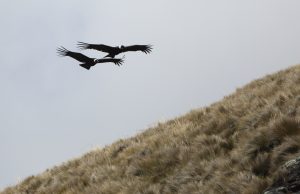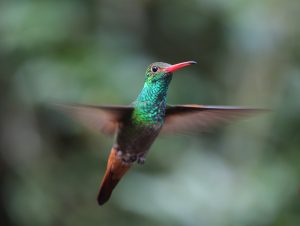So here we are in Quito, working our way through the early morning traffic en route to the Yanacocha cloud forest reserve, where, at around 11300 feet, the air is preciously scarce, and yet the hummingbirds here have no problem pursuing their enormously energetic lifestyles. A selection of feeders here attract higher altitude species, such as Shining Sunbeam, Tyrian Metaltail, Buff-winged Starfrontlet, Mountain Velvetbreast, Sapphire-vented and Golden-breasted Pufflegs with fluffy white ‘boots’, the hefty Great Sapphirewing, with a six inch long body, and the unique Sword-billed Hummingbird, with an incredibly long ‘lance’ for a bill, which is actually longer than its body! Other visitors to the feeders include Masked and Glossy Flowerpiercers, Great Thrush and Yellow-breasted Brushfinch, plus Black-chested and Scarlet-bellied Mountain-Tanagers. Beyond the feeders, a level track follows the contours of the vertiginous forested slopes, where new sightings include White-banded Tyrannulet, Superciliared Hemispingus, Rufous Antpitta, and a Tawny Antpitta, actually hopping along the track ahead of us like a long-legged, tailless juvenile Robin.
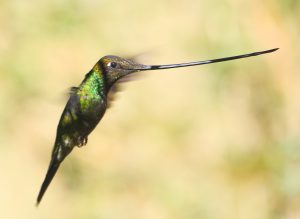
After lunch at Yanacocha, a bumpy road winds along the bottom of the Rio Alimbi valley, where roadside birds include Plumbeous Pigeon, Streaked Tuftedcheek, Cinnamon Flycatcher, Black Phoebe, Blue-winged Mountain-Tanager and Glossy-black Thrush, looking like our own Blackbird, but with yellow legs. Deep in the valley is the Alimbi Lodge, where the garden birds have to be seen to be believed. A couple of logs laden with bananas attract a steady stream of frugivores like Golden, Silver-throated, Black-capped, White-lined, Lemon-rumped and Bue-grey Tanagers, plus Buff-throated Saltator and Red-tailed Squirrel. However, this is a side show to a dozen or so hanging sugar feeders, which attract a mind-blowing frenzy of hummingbirds, amounting to literally hundreds, all buzzing, whirring and twittering within feet of the verandah! Amongst the melee our brilliant local guide points out a staggering nineteen different species, including White-whiskered and Tawny-bellied Hermits, White-necked Jacobin, Brown, Lesser and Sparkling Violetears, Crowned Woodnymph, Andean and Western Emeralds, Fawn-breasted and Green-crowned Brilliants, Brown Inca, Purple-bibbed Whitetip, Rufous-tailed and Speckled Hummingbirds, the flamboyant Booted Rackettail, and the tiny Purple-throated Woodstar. What a dazzling star-studded show that was.
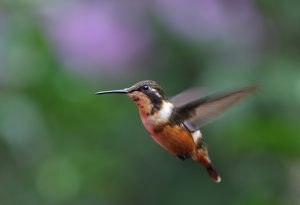
We set off before dawn this morning, for Rio Silanche, spotting Grey-headed and Hook-billed Kites, Choco Toucan, Ruddy Pigeon and a pair of powerful Guayaquil Woodpeckers along the way. The bumpy dirt road winds deeper into the forest, and eventually crosses the Rio Silanche, where we enjoy a picnic breakfast while watching an impressive Pale-mandibled Aracari posing in the scope. The main attraction here is a tall tower offering eye level views of the forest canopy, where we soon get close views of Streaked Flycatcher, Choco Tyrannulet, Yellow-throated Toucan, Golden-olive and Lineated Woodpeckers, a perky little Red-rumped Woodpecker and a stunning male Yellow-tufted Dacnis. For the best part of two hours a steady stream of sightings appear every few minutes, including in order of appearance, Palm and Bay-headed Tanagers, Orange-bellied Euphonia, Roadside Hawk, Grey-and-gold, Blue-necked and Golden-hooded Tanagers and a superb pair of Barred Puffbirds, which arrive and then pose close by for most of the morning stakeout, while the stream of new birds continues with Piratic Flycatcher, Double-toothed Kite and a pair of Black-cheeked Woodpeckers. With five different woodpeckers ‘bagged’ this morning, it’s no wonder the adjacent dead palm tree trunk is riddled with numerous nest holes in a range of sizes. Sightings from the tower continue with Purple Honeycreeper, Tropical Kingbird, and “something yellow” spotted by Ashley; a male White-tailed Trogon, followed by Black-and-white Becard, a magnificent male Scarlet-browed Tanager, a Purple-crowned Fairy and a male Green Honeycreeper. Back down to earth, a short stroll produces White-bearded Manakin, Orange-fronted Barbet, Boat-billed Flycatcher, Purple-throated Fruitcrow and Southern Rough-winged Swallow, with two big Blue Morpho butterflies chasing each other above the river. On the way back to Septimo Paraiso for lunch, we make an emergency stop and pile out for a wonderful photo-opportunity with a male Gartered Trogon.
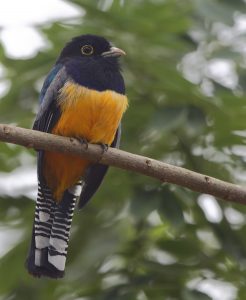
This afternoon, some chill out in the hot pool in ‘seventh heaven’, while others explore downtown Mindo, where the garden birds include Black Phoebe, Rusty-margined and Social Flycatchers, Shiny Cowbird, Bananaquit, Blue-and-white Swallow, House Wren, Slaty and Red-faced Spinetails, and the humbug-patterned Pacific Antwren. From a bridge over the Rio Nambillo, new sightings include Spotted Sandpiper, Torrent Tyrannulet, Fawn-breasted Tanager, and an exotic-looking ‘Jesus Christ’ Basilisk Lizard, with a red and white throat, dark green spiky back, and a white-patterned ‘sail’ on the back of its head, just like a miniature dinosaur!
We set off at first light for a visit to a Cock-of-the-rock lek, and as we descend the path towards the display area, we can hear their raucous squawks and squeals, sounding rather like strangled pigs. Once in position, we witness the spectacular performance of around a dozen vivid scarlet males, with strange pompoms on their foreheads and high on testosterone, bowing, wing-flapping, and occasionally locking beaks and plummeting to the ground. The spectacle continues for over an hour, and they do this from dawn, every morning throughout the year! During the action, the metallic fluty song of the Andean Solitaire rings out across the valley, and we even scope a Rufous-bellied Nighthawk, roosting on a mossy branch, thanks to Angel Paz, the ‘pitta bread man’, who has several more treats in store, beginning with a mother Lyre-tailed Nightjar snuggled up with her chick, and then a second female asleep on a rocky ledge at eye level right next to the road! For his next ‘trick’ he places a banana on the ground a little further along the road, which instantly brings in a pair of Dark-backed Wood-Quail, along with a chick. Cue the Antpittas. At the end of the dirt road, a track leads into the cloud forest, where Angel places a few worms on a log, whistles softly, and encourages his first invisible ‘pet’ into view saying “venga, venga, venga”. A gorgeous Chestnut-crowned Antpitta patters along the log, like a supermodel on a catwalk, complete with whirring cameras, making several encores, before we move on to Antpitta two, a Yellow-breasted Antpitta, again enticed into the open with worms, whistles and vocal encouragement! From the same track we also get nice views of Golden-headed Quetzal and the multi-coloured Plate-billed Mountain-Toucan, before retracing our route down to Angel’s house, where a narrow path descends into the forest home of an Ochre-breasted Antpitta called Shakira, so called because of her unusual habit of twisting from side to side like a singer! The same short path provides startling views of Susanna the Moustached Antpitta, and I am not making this up! That’s first class views of four Antpittas by 10am! Back at Angel’s house, breakfast is served on a balcony with a panoramic view of the forested valley down below and cracking close eye level views of a colourful selection of birds like Crimson-rumped Toucanet, Toucan Barbet, Orange-bellied Euphonia, Masked Flowerpiercer, Blue-winged and Black-chinned Mountain-Tanagers, and Blue-grey, Palm, Golden, Flame-faced and Golden-naped Tanagers. Try picking a star bird out of that lot!
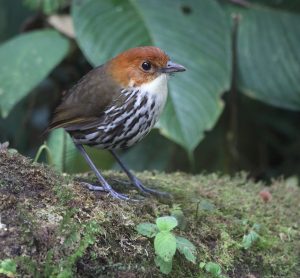
From here, it’s a slow, winding, bone-shaking drive on a dirt track, which would normally be considered unsuitable for heavy vehicles, with long drops on either side, and yet Edgar, our driver makes it all look so easy. Journey’s end is the Guallabamba Valley, where a narrow chasm is used as a roosting site by Oilbirds, a bizarre fruit-eating member of the Nightjar family which usually roosts in caves, but here they are starring at us from their ledges just a few feet above our heads in broad daylight! It’s now time for lunch along with a lovely Monarch-type butterfly and birds like Pacific Hornero, Red-eyed Vireo, Rusty-margined Flycatcher, Rufous-collared Sparrow and Variable Seedeater. Back in Seventh Heaven, there is still time to enjoy all the Hummingbirds around the feeders in the lodge grounds. What a fabulous day’s birding.

Today we visit the Mashpi Conservation Area, with extensive cloud forest ranging from 2470 to 5610 feet above sea level. This is part of the Choco region with 22 regional endemics. Clouds drifting across the wooded slopes create an ethereal atmosphere amongst the tall trees, festooned with thick mosses and red-flowering Bromeliads, where early birds include Thick-billed Seed-Finch, a very skulking Nariño Tapaculo, plus Slaty Antwren, Three-striped Warbler, Slate-throated Whitestart, and just as the sun comes out, a Spotted Woodcreeper, right above Ashley’s ‘polished walnut head’. Further along the dirt road, we also find a stunning male Orange-breasted Fruiteater, one of the local endemics, followed by Brown-billed Scythebill, a cinnamon female One-coloured Becard and Uniform Treehunter, with a Hoffmann’s Two-toed Sloth hanging out, allowing us time to add Black-billed Peppershrike to the list before having a closer look at the Sloth in the scope, as it wasn’t going to run away! Next new sighting is the tiny blue and yellow Tropical Parula, followed by a blue-eyed Rose-faced Parrot feeding on a bunch of bananas at the Amagusa smallholding, with a very lively feeding station, attracting Toucan Barbet, Black-chinned Mountain-Tanager, Lemon-rumped, Blue-grey, Golden-naped, Rufous-throated, Flame-faced and Golden Tanagers, the well named Glistening-green Tanager and the lovely Golden-collared Honeycreeper, which all scatter each time the Crimson-rumped Toucanet arrives. Meanwhile the hanging sugar feeders are buzzing with hummers like Green Thorntail, Andean Emerald, Purple-bibbed Whitetip, Velvet-purple Coronet, Violet-tailed Sylph and Empress Brilliant. Moving on, a second feeding station adds Black-winged Saltator and Moss-backed Tanager to the growing list, while a stroll amongst a variety of colourful butterflies also produces Lesser Greenlet, a male One-coloured Becard, Wedge-billed Woodcreeper, Yellow-throated Bush-Tanager, Buff-rumped Warbler and a delightful little Ornate Flycatcher.
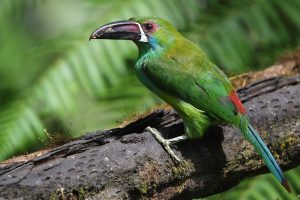
After a picnic lunch, a stroll along the dirt track-cum-road produces Russet Antshrike, Fulvous-breasted Flatbill, Ochre-breasted Tanager and a superb male Choco Trogon, with a green breast, deep red belly and an iridescent blue-green sheen on the back. Today’s grand finale is a male Lyre-tailed Nightjar, roosting on a bare branch hanging down against a bare cliff face, with a remarkable curly tail, which is more than double the length of its body!
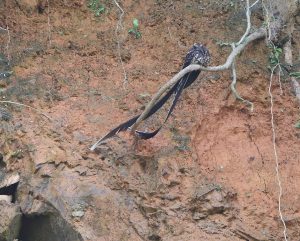
This morning we visit the Bellavista reserve in towering pristine forest, up in the clouds at around 7300 feet above sea level, where ‘car park’ birds include White-tailed Tyrannulet, White-sided Flowerpiercer, Russet-crowned Warbler, Golden-crowned Flycatcher, Collared Inca and Gorgeted Sunangel, with a very tame male Masked Trogon, perching on various beams that make up part of the lodge. Following a tip off, a short drive down the bumpy road, leads to a Common Potoo ‘glued’ to the top of a dead tree stump right next to the road, providing plum views in the scope, as it slowly rotates like a clockwork model, while squinting at us through narrowed eyelids. After lunch back at Septimo Paraiso, it’s sadly time to say goodbye to the friendly staff and head back toward Quito, where a visit to La Mitad del Mundo (the Centre of the World) slap bang on the equator, allows an opportunity to try ‘party tricks’ like balancing an egg on the head of a nail, and watching water go opposite ways down a plug hole, just a few feet either side of the 0°0’0” red line!
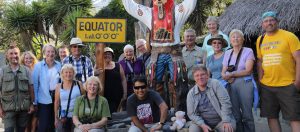
Now that we have acclimatised to high altitude, we aim high with a visit to Antisana, a snow-capped volcano reaching 18891 feet above sea level. On the way up, we stop for a welcome cup of hot tea at the aptly named Tambo Condor Restaurant, just as a magnificent adult Andean Condor drifts above the line of cliffs across the valley! After that ‘Condor moment’ and a warm up by the log fire, new birds right outside include Black Flowerpiercer, Giant Hummingbird, Black-chested Buzzard-Eagle, whose six foot wingspan looks small compared to the Condor, and the amazing male Black-tailed Trainbearer, a hummingbird with a tail longer than its body! A short stroll down to a spectacular viewpoint looking out onto a ravine dammed by a nineteenth century lava flow, adds views of Black-billed Shrike-Tyrant, Carunculated Caracara, Plain-coloured Seedeater, Andean Gulls, Coots and Teals, Yellow-billed Pintail, Tyrian Metaltail, White-crested Elaenia, Tufted Tit-Tyrant and a pair of Hooded Siskins. Driving ever higher, we make an emergency stop for an American Kestrel, posing on a roadside post. Higher still, a stop at a bridge over a fast flowing stream in a landscape reminiscent of the North Pennines, produces Brown-bellied Swallow, Cinereous Conebill, Andean Tit-Spinetail, a female Ecuadorian Hillstar and a well concealed Band-winged Nightjar, an unbelievable spotting by Juan Carlos. Onward and upward, the next stop produces Many-striped Canastero, Plumbeous Sierra-Finch and both Stout-billed and Chestnut-winged Cinclodeses, feeding close by on the short Paramo turf, with an awesome synchronised fly over by a couple of adult Condors, close enough to show their white ruffs, bare grey heads and hooked beaks! Just over the next brow, a carcass has attracted a gathering of at least sixteen Condors, with a further eleven either resting on the Paramo or circling above. Even Juan Carlos in twenty six years’ guiding has never seen so many in one place! At around 13,000 feet, the scenery is literally breathtaking, with Antisana’s rugged snow-clad peak disappearing into the clouds. New sightings continue to appear including Andean Lapwing, Black-winged Ground-Doves, Black-faced Ibises, a small herd of White-tailed Deer and an Andean Fox, sauntering through the yellow grass like a Jackal in the Serengeti. By the time we get back to the restaurant for lunch, the fire has gone out and the sun is beaming down from directly overhead, casting very short shadows. Back at the Hacienda, we have some free time to reflect on today’s fabulous experiences.
By the end of this wonderfully productive and memorable trip, we had seen over 230 species of birds, including a staggering 37 different Hummingbirds!


